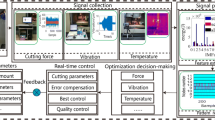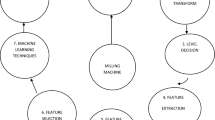Abstract
This paper proposes an online prediction method for the roundness of grinding workpieces based on vibration signals. Vibration sensors are used to collect vibration signals during grinding, and wavelet packet denoising is used to preprocess original signals to obtain effective vibration signals. Then use time domain analysis and frequency domain analysis to extract features and normalize them to form feature vectors. The roundness of the finished workpiece is measured using a shape-measuring instrument and integrated with the feature vectors to generate a usable data set. The support vector machine (SVM) algorithm is implemented using A Library for Support Vector Machines (LIBSVM), and a prediction model is constructed. Use the data set to train the model and evaluate the accuracy of the model to verify the effectiveness of the model. The results show that the prediction accuracy of the prediction method can reach 92.86%, and it can better predict whether the roundness is qualified.







Similar content being viewed by others
Data availability
All the data are obtained by experiments and are authentic.
Code availability
The code we wrote can support the normal operation of the system.
References
Kopac J, Krajnik P (2006) High-performance grinding—a review. J Mater Process Technol 175:278–284. https://doi.org/10.1016/j.jmatprotec.2005.04.010
Lu Y, Liu C, Wang KI-K, Huang H, Xu X (2020) Digital twin-driven smart manufacturing: connotation, reference model, applications and research issues. Robot Comput-Integr Manuf 61:101837. https://doi.org/10.1016/j.rcim.2019.101837
Brinksmeier E, TÖnshoff HK, Czenkusch C, Heinzel C (1998) Modelling and optimization of grinding processes. J Intell Manuf 9:303–314. https://doi.org/10.1023/A:1008908724050
Brinksmeier E, Aurich JC, Govekar E, Heinzel C, Hoffmeister H-W, Klocke F, Peters J, Rentsch R, Stephenson DJ, Uhlmann E, Weinert K, Wittmann M (2006) Advances in modeling and simulation of grinding processes. CIRP Ann 55:667–696. https://doi.org/10.1016/j.cirp.2006.10.003
Kwak J-S, Ha M-K (2004) Intelligent diagnostic technique of machining state for grinding. Int J Adv Manuf Technol 23:436–443. https://doi.org/10.1007/s00170-003-1899-0
Lezanski P (2001) An intelligent system for grinding wheel condition monitoring. J Mater Process Technol 109:258–263. https://doi.org/10.1016/S0924-0136(00)00808-6
Cheng C, Li J, Liu Y, Nie M, Wang W (2019) Deep convolutional neural network-based in-process tool condition monitoring in abrasive belt grinding. Comput Ind 106:1–13. https://doi.org/10.1016/j.compind.2018.12.002
Yang Z, Yu Z (2012) Grinding wheel wear monitoring based on wavelet analysis and support vector machine. Int J Adv Manuf Technol 62:107–121. https://doi.org/10.1007/s00170-011-3797-1
Hassui A, Diniz AE (2003) Correlating surface roughness and vibration on plunge cylindrical grinding of steel. Int J Mach Tools Manuf 43:855–862. https://doi.org/10.1016/S0890-6955(03)00049-X
Yao Z, Mei D, Chen Z (2010) On-line chatter detection and identification based on wavelet and support vector machine. J Mater Process Technol 210:713–719. https://doi.org/10.1016/j.jmatprotec.2009.11.007
Thomazella R, Lopes WN, Aguiar PR, Alexandre FA, Fiocchi AA, Bianchi EC (2019) Digital signal processing for self-vibration monitoring in grinding: a new approach based on the time-frequency analysis of vibration signals. Measurement 145:71–83. https://doi.org/10.1016/j.measurement.2019.05.079
Mahata S, Shakya P, Babu NR, Prakasam PK (2020) In-process characterization of surface finish in cylindrical grinding process using vibration and power signals. Procedia CIRP 88:335–340. https://doi.org/10.1016/j.procir.2020.05.058
Mahata S, Shakya P, Babu NR (2021) A robust condition monitoring methodology for grinding wheel wear identification using Hilbert Huang transform. Precis Eng 70:77–91. https://doi.org/10.1016/j.precisioneng.2021.01.009
Subrahmanya N, Shin YC (2008) Automated sensor selection and fusion for monitoring and diagnostics of plunge grinding. J Manuf Sci Eng 130 https://doi.org/10.1115/1.2927439
Hassui A, Diniz AE, Oliveira JFG, Felipe J, Gomes JJF (1998) Experimental evaluation on grinding wheel wear through vibration and acoustic emission. Wear 217:7–14. https://doi.org/10.1016/S0043-1648(98)00166-5
Yeh L-J, Lai G-J (1995) A study of the monitoring and suppression system for turning slender workpieces. Proc Inst Mech Eng Part B J Eng Manuf 209:227–236. https://doi.org/10.1243/PIME_PROC_1995_209_077_02
Cortes C, Vapnik V (1995) Support-vector networks. Mach Learn 20:273–297. https://doi.org/10.1007/BF00994018
Burges CJC (1998) A tutorial on support vector machines for pattern recognition. Data Min Knowl Discov 2:121–167. https://doi.org/10.1023/A:1009715923555
Ekici S (2009) Classification of power system disturbances using support vector machines. Expert Syst Appl 36:9859–9868. https://doi.org/10.1016/j.eswa.2009.02.002
Widodo A, Yang B-S (2007) Support vector machine in machine condition monitoring and fault diagnosis. Mech Syst Signal Process 21:2560–2574. https://doi.org/10.1016/j.ymssp.2006.12.007
Liakos KG, Busato P, Moshou D, Pearson S, Bochtis D (2018) Machine learning in agriculture: a review. Sensors 18:2674. https://doi.org/10.3390/s18082674
Chang C-C, Lin C-J (2011) LIBSVM: a library for support vector machines. ACM Trans Intell Syst Technol 2:27:1-27:27. https://doi.org/10.1145/1961189.1961199
Funding
This work was supported by the Key R&D Program of Zhejiang Province (2020C01033).
Author information
Authors and Affiliations
Contributions
All authors contributed to the study. Chu Ning and Kang Weimin formulated the experimental plan, processed the data, and verified the prediction model. Kang Weimin wrote the first draft of the paper, Fu Jianzhong and Yao Xinhua determined the research direction and experimental purpose of the paper, and revised the paper. All authors read and approved the final manuscript.
Corresponding authors
Ethics declarations
Ethics approval
Not applicable.
Consent to participate
All authors read and approved the final manuscript.
Consent for publication
All authors agree to publish in The International Journal of Advanced Manufacturing Technology.
Competing interests
The authors declare no interests.
Additional information
Publisher's note
Springer Nature remains neutral with regard to jurisdictional claims in published maps and institutional affiliations.
Rights and permissions
Springer Nature or its licensor (e.g. a society or other partner) holds exclusive rights to this article under a publishing agreement with the author(s) or other rightsholder(s); author self-archiving of the accepted manuscript version of this article is solely governed by the terms of such publishing agreement and applicable law.
About this article
Cite this article
Chu, N., Kang, W., Yao, X. et al. Online roundness prediction of grinding workpiece based on vibration signals and support vector machine. Int J Adv Manuf Technol 126, 2733–2743 (2023). https://doi.org/10.1007/s00170-023-11206-6
Received:
Accepted:
Published:
Issue Date:
DOI: https://doi.org/10.1007/s00170-023-11206-6




